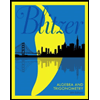
EBK GRAPHICAL APPROACH TO ALGEBRA & TRI
7th Edition
ISBN: 9780134674377
Author: Rockswold
Publisher: VST
expand_more
expand_more
format_list_bulleted
Concept explainers
Question
Chapter 4.3, Problem 11E
To determine
The polynomial P(x) of degree 3 with real coefficients having zeros 4 and 1+i such that it satisfies the condition P(2)=4.
Expert Solution & Answer
Want to see the full answer?
Check out a sample textbook solution
Students have asked these similar questions
[2
01
3. (12 pts) Let A =
1
1 and b = 1
L2
1]
213
[2]
(1)
(2)
Use the Gram-Schmidt process to find an orthonormal basis for the column
space of A.
Factor A into a product QR, where Q has an orthonormal set of column
vectors and R is upper triangular.
(3) Solve the least squares problem Ax = b.
22.) Mr. Vedrani has a pool with a deck built around it. The equation (2x+14)(2x+19) = 650
represents the relationship of the side lengths (in feet) of the entire pool area (in square feet).
a.) If 350 represents the area of the pool and deck area, what do the expressions (2x+14)
and (2x+19) each represent?
b.)
Using graphing technology, find x, the width of the deck around the pool. If necessary,
round to the nearest tenth.
x=
How do I get common factors?
Chapter 4 Solutions
EBK GRAPHICAL APPROACH TO ALGEBRA & TRI
Ch. 4.1 - CONCEPT CHECK Use the polynomial function graphs,...Ch. 4.1 - CONCEPT CHECK Use the polynomial function graphs,...Ch. 4.1 - CONCEPT CHECK Use the polynomial function graphs,...Ch. 4.1 - CONCEPT CHECK Use the polynomial function graphs,...Ch. 4.1 - CONCEPT CHECK Use the polynomial function graphs,...Ch. 4.1 - CONCEPT CHECK Use the polynomial function graphs,...Ch. 4.1 - CONCEPT CHECK Use the polynomial function graphs,...Ch. 4.1 - CONCEPT CHECK Use the polynomial function graphs,...Ch. 4.1 - Use an end behavior diagram , , , or to describe...Ch. 4.1 - Use an end behavior diagram , , , or to describe...
Ch. 4.1 - Use an end behavior diagram , , , or to describe...Ch. 4.1 - Use an end behavior diagram , , , or to describe...Ch. 4.1 - Use an end behavior diagram , , , or to describe...Ch. 4.1 - Use an end behavior diagram , , , or to describe...Ch. 4.1 - Use an end behavior diagram , , , or to describe...Ch. 4.1 - Use an end behavior diagram , , , or to describe...Ch. 4.1 - Use an end behavior diagram , , , or to describe...Ch. 4.1 - Use an end behavior diagram , , , or to describe...Ch. 4.1 - Use an end behavior diagram , , , or to describe...Ch. 4.1 - Prob. 20ECh. 4.1 - Prob. 21ECh. 4.1 - Prob. 22ECh. 4.1 - Prob. 23ECh. 4.1 - Prob. 24ECh. 4.1 - Prob. 25ECh. 4.1 - Prob. 26ECh. 4.1 - Prob. 27ECh. 4.1 - Prob. 28ECh. 4.1 - Prob. 29ECh. 4.1 - Prob. 30ECh. 4.1 - Prob. 31ECh. 4.1 - Prob. 32ECh. 4.1 - Without using a calculator, match each function in...Ch. 4.1 - Prob. 34ECh. 4.1 - Without using a calculator, match each function in...Ch. 4.1 - Prob. 36ECh. 4.1 - Prob. 37ECh. 4.1 - Prob. 38ECh. 4.1 - Prob. 39ECh. 4.1 - Prob. 40ECh. 4.1 - Prob. 41ECh. 4.1 - Prob. 42ECh. 4.1 - Prob. 43ECh. 4.1 - Prob. 44ECh. 4.1 - CONCEPT CHECK The graphs below show
but not...Ch. 4.1 - Prob. 46ECh. 4.1 - CONCEPT CHECK The graphs below show
y = x3 − 3x2 −...Ch. 4.1 - Prob. 48ECh. 4.1 - CONCEPT CHECK The graphs below show
but not...Ch. 4.1 - Prob. 50ECh. 4.1 - CONCEPT CHECK The graphs below show
y = x3 − 3x2 −...Ch. 4.1 - Prob. 52ECh. 4.1 - CONCEPT CHECK The graphs below show
y = x3 − 3x2 −...Ch. 4.1 - Prob. 54ECh. 4.1 - Prob. 55ECh. 4.1 - Prob. 56ECh. 4.1 - Prob. 57ECh. 4.1 - Prob. 58ECh. 4.1 - Prob. 59ECh. 4.1 - Prob. 60ECh. 4.1 - Prob. 61ECh. 4.1 - Prob. 62ECh. 4.1 - Prob. 63ECh. 4.1 - Prob. 64ECh. 4.1 - Prob. 65ECh. 4.1 - Prob. 66ECh. 4.1 - Prob. 67ECh. 4.1 - Prob. 68ECh. 4.1 - Prob. 69ECh. 4.1 - Prob. 70ECh. 4.1 - Prob. 71ECh. 4.1 - Prob. 72ECh. 4.1 - Prob. 73ECh. 4.1 - Prob. 74ECh. 4.2 - CHECKING ANALYTIC SKILLS Simplify each rational...Ch. 4.2 - CHECKING ANALYTIC SKILLS Simplify each rational...Ch. 4.2 - Prob. 3ECh. 4.2 - Prob. 4ECh. 4.2 - CHECKING ANALYTIC SKILLS Simplify each rational...Ch. 4.2 - Prob. 6ECh. 4.2 - Prob. 7ECh. 4.2 - Prob. 8ECh. 4.2 - Use the intermediate value theorem to show that...Ch. 4.2 - Prob. 10ECh. 4.2 - Prob. 11ECh. 4.2 - Prob. 12ECh. 4.2 - Use the intermediate value theorem to show that...Ch. 4.2 - Prob. 14ECh. 4.2 - Prob. 15ECh. 4.2 - Prob. 16ECh. 4.2 - Use the intermediate value theorem to show that...Ch. 4.2 - Prob. 18ECh. 4.2 - CONCEPT CHECK Suppose that a polynomial function P...Ch. 4.2 - Prob. 20ECh. 4.2 - Find each quotient when P(x) is divided by the...Ch. 4.2 - Prob. 22ECh. 4.2 - Prob. 23ECh. 4.2 - Prob. 24ECh. 4.2 - Find each quotient when P(x) is divided by the...Ch. 4.2 - Prob. 26ECh. 4.2 - Prob. 27ECh. 4.2 - Prob. 28ECh. 4.2 - Find each quotient when P(x) is divided by the...Ch. 4.2 - Prob. 30ECh. 4.2 - Prob. 31ECh. 4.2 - Prob. 32ECh. 4.2 - Use synthetic substitution to find P(k).
k = 3;...Ch. 4.2 - Prob. 34ECh. 4.2 - Prob. 35ECh. 4.2 - Prob. 36ECh. 4.2 - Use synthetic substitution to find P(k).
k = 2;...Ch. 4.2 - Prob. 38ECh. 4.2 - Prob. 39ECh. 4.2 - Prob. 40ECh. 4.2 - Use synthetic substitution to find P(k).
; P(x) =...Ch. 4.2 - Prob. 42ECh. 4.2 - Prob. 43ECh. 4.2 - Prob. 44ECh. 4.2 - Use synthetic substitution to determine whether...Ch. 4.2 - Prob. 46ECh. 4.2 - Prob. 47ECh. 4.2 - Prob. 48ECh. 4.2 - Use synthetic substitution to determine whether...Ch. 4.2 - Prob. 50ECh. 4.2 - Prob. 51ECh. 4.2 - Prob. 52ECh. 4.2 - Use synthetic substitution to determine whether...Ch. 4.2 - Prob. 54ECh. 4.2 - Prob. 55ECh. 4.2 - Prob. 56ECh. 4.2 - Prob. 57ECh. 4.2 - Prob. 58ECh. 4.2 - Prob. 59ECh. 4.2 - Prob. 60ECh. 4.2 - For each polynomial at least one zero is given....Ch. 4.2 - Prob. 62ECh. 4.2 - For each polynomial at least one zero is given....Ch. 4.2 - Prob. 64ECh. 4.2 - For each polynomial at least one zero is given....Ch. 4.2 - For each polynomial at least one zero is given....Ch. 4.2 - Prob. 67ECh. 4.2 - Prob. 68ECh. 4.2 - For each polynomial at least one zero is given....Ch. 4.2 - Prob. 70ECh. 4.2 - Prob. 71ECh. 4.2 - Prob. 72ECh. 4.2 - Factor P(x) into linear factors given that k is a...Ch. 4.2 - Prob. 74ECh. 4.2 - Prob. 75ECh. 4.2 - Prob. 76ECh. 4.2 - Factor P(x) into linear factors given that k is a...Ch. 4.2 - Prob. 78ECh. 4.2 - Prob. 79ECh. 4.2 - Prob. 80ECh. 4.2 - Divide.
Ch. 4.2 - Prob. 82ECh. 4.2 - Divide.
Ch. 4.2 - Prob. 84ECh. 4.2 - Divide.
Ch. 4.2 - Prob. 86ECh. 4.2 - Prob. 87ECh. 4.2 - Prob. 88ECh. 4.2 - Prob. 89ECh. 4.2 - Prob. 90ECh. 4.2 - Prob. 91ECh. 4.2 - Prob. 92ECh. 4.2 - Prob. 1RBCCh. 4.2 - Prob. 2RBCCh. 4.2 - Prob. 3RBCCh. 4.2 - Prob. 4RBCCh. 4.2 - Prob. 5RBCCh. 4.2 - Prob. 6RBCCh. 4.2 - Prob. 7RBCCh. 4.2 - Prob. 8RBCCh. 4.2 - Prob. 9RBCCh. 4.2 - Prob. 10RBCCh. 4.3 - CHECKING ANALYTIC SKILLS Find a cubic polynomial...Ch. 4.3 - Prob. 2ECh. 4.3 - CHECKING ANALYTIC SKILLS Find a cubic polynomial...Ch. 4.3 - Prob. 4ECh. 4.3 - CHECKING ANALYTIC SKILLS Find a cubic polynomial...Ch. 4.3 - CHECKING ANALYTIC SKILLS Find a cubic polynomial...Ch. 4.3 - CHECKING ANALYTIC SKILLS Find a polynomial...Ch. 4.3 - Prob. 8ECh. 4.3 - CHECKING ANALYTIC SKILLS Find a polynomial...Ch. 4.3 - Prob. 10ECh. 4.3 - CHECKING ANALYTIC SKILLS Find a polynomial...Ch. 4.3 - Prob. 12ECh. 4.3 - One or more zeros are given for each polynomial....Ch. 4.3 - Prob. 14ECh. 4.3 - One or more zeros are given for each polynomial....Ch. 4.3 - Prob. 16ECh. 4.3 - One or more zeros are given for each polynomial....Ch. 4.3 - Prob. 18ECh. 4.3 - Find a polynomial function P(x) having leading...Ch. 4.3 - Prob. 20ECh. 4.3 - Find a polynomial function P(x) having leading...Ch. 4.3 - Prob. 22ECh. 4.3 - Find a polynomial function P(x) having leading...Ch. 4.3 - Prob. 24ECh. 4.3 - Prob. 25ECh. 4.3 - Prob. 26ECh. 4.3 - Find a polynomial function P(x) having leading...Ch. 4.3 - Prob. 28ECh. 4.3 - Prob. 29ECh. 4.3 - Prob. 30ECh. 4.3 - Sketch by hand the graph of each function. (You...Ch. 4.3 - Prob. 32ECh. 4.3 - Sketch by hand the graph of each function. (You...Ch. 4.3 - Prob. 34ECh. 4.3 - Sketch by hand the graph of each function. (You...Ch. 4.3 - Prob. 36ECh. 4.3 - Sketch by hand the graph of each function. (You...Ch. 4.3 - Prob. 38ECh. 4.3 - Prob. 39ECh. 4.3 - Prob. 40ECh. 4.3 - CONCEPT CHECK Use the graphs in Exercises 41–46 to...Ch. 4.3 - CONCEPT CHECK Use the graphs in Exercises 41–46 to...Ch. 4.3 - CONCEPT CHECK Use the graphs in Exercises 41–46 to...Ch. 4.3 - Prob. 44ECh. 4.3 - CONCEPT CHECK Use the graphs in Exercises 41–46 to...Ch. 4.3 - Prob. 46ECh. 4.3 - Prob. 47ECh. 4.3 - Prob. 48ECh. 4.3 - Prob. 49ECh. 4.3 - Prob. 50ECh. 4.3 - Prob. 51ECh. 4.3 - Prob. 52ECh. 4.3 - For each polynomial function, (a) list all...Ch. 4.3 - Prob. 54ECh. 4.3 - For each polynomial function, (a) list all...Ch. 4.3 - Prob. 56ECh. 4.3 - For each polynomial function, (a) list all...Ch. 4.3 - Prob. 58ECh. 4.3 - Prob. 59ECh. 4.3 - Prob. 60ECh. 4.3 - Prob. 61ECh. 4.3 - Prob. 62ECh. 4.3 - Prob. 63ECh. 4.3 - Prob. 64ECh. 4.3 - Prob. 65ECh. 4.3 - Prob. 66ECh. 4.3 - Prob. 67ECh. 4.3 - Prob. 68ECh. 4.3 - Prob. 69ECh. 4.3 - Prob. 70ECh. 4.3 - Prob. 71ECh. 4.3 - Prob. 72ECh. 4.3 - Prob. 73ECh. 4.3 - Prob. 74ECh. 4.3 - Prob. 75ECh. 4.3 - Prob. 76ECh. 4.3 - Prob. 77ECh. 4.3 - Prob. 78ECh. 4.3 - Prob. 79ECh. 4.3 - Prob. 80ECh. 4.3 - Prob. 81ECh. 4.3 - Prob. 82ECh. 4.3 - Prob. 83ECh. 4.3 - Prob. 84ECh. 4.3 - Prob. 85ECh. 4.3 - Prob. 86ECh. 4.3 - Prob. 87ECh. 4.3 - Prob. 88ECh. 4.3 - Prob. 89ECh. 4.3 - Prob. 90ECh. 4.3 - Prob. 91ECh. 4.3 - Prob. 92ECh. 4.3 - RELATING CONCEPTS For individual or group...Ch. 4.3 - Prob. 94ECh. 4.3 - Prob. 95ECh. 4.3 - do the following in order.
Use Descartes’ rule of...Ch. 4.3 - Prob. 97ECh. 4.3 - Prob. 98ECh. 4.4 - Prob. 1ECh. 4.4 - Prob. 2ECh. 4.4 - Prob. 3ECh. 4.4 - Prob. 4ECh. 4.4 - Prob. 5ECh. 4.4 - Prob. 6ECh. 4.4 - Prob. 7ECh. 4.4 - Prob. 8ECh. 4.4 - CHECKING ANALYTIC SKILLS Find all real solutions....Ch. 4.4 - Prob. 10ECh. 4.4 - Prob. 11ECh. 4.4 - Prob. 12ECh. 4.4 - CHECKING ANALYTIC SKILLS Find all complex...Ch. 4.4 - Prob. 14ECh. 4.4 - Prob. 15ECh. 4.4 - Prob. 16ECh. 4.4 - CHECKING ANALYTIC SKILLS Find all complex...Ch. 4.4 - Prob. 18ECh. 4.4 - Prob. 19ECh. 4.4 - Solve each equation analytically for all complex...Ch. 4.4 - Solve each equation analytically for all complex...Ch. 4.4 - Prob. 22ECh. 4.4 - Prob. 23ECh. 4.4 - Prob. 24ECh. 4.4 - Prob. 25ECh. 4.4 - Prob. 26ECh. 4.4 - Prob. 27ECh. 4.4 - Prob. 28ECh. 4.4 - Prob. 29ECh. 4.4 - Prob. 30ECh. 4.4 - Prob. 31ECh. 4.4 - Prob. 32ECh. 4.4 - Prob. 33ECh. 4.4 - Prob. 34ECh. 4.4 - Prob. 35ECh. 4.4 - Prob. 36ECh. 4.4 - Graph each polynomial function by hand, as shown...Ch. 4.4 - Prob. 38ECh. 4.4 - Graph each polynomial function by hand, as shown...Ch. 4.4 - Prob. 40ECh. 4.4 - Graph each polynomial function by hand, as shown...Ch. 4.4 - Prob. 42ECh. 4.4 - Prob. 43ECh. 4.4 - Prob. 44ECh. 4.4 - Prob. 45ECh. 4.4 - Prob. 46ECh. 4.4 - Prob. 47ECh. 4.4 - Prob. 48ECh. 4.4 - Prob. 49ECh. 4.4 - Prob. 50ECh. 4.4 - Prob. 51ECh. 4.4 - Prob. 52ECh. 4.4 - Prob. 53ECh. 4.4 - Prob. 54ECh. 4.4 - Find all n complex solutions of each equation of...Ch. 4.4 - Prob. 56ECh. 4.4 - Prob. 57ECh. 4.4 - Prob. 58ECh. 4.4 - Find all n complex solutions of each equation of...Ch. 4.4 - Prob. 60ECh. 4.4 - Prob. 61ECh. 4.4 - Prob. 62ECh. 4.4 - Find all n complex solutions of each equation of...Ch. 4.4 - Prob. 64ECh. 4.4 - Prob. 65ECh. 4.4 - Prob. 66ECh. 4.4 - Prob. 67ECh. 4.4 - Prob. 68ECh. 4.4 - Prob. 69ECh. 4.4 - Prob. 70ECh. 4.4 - Prob. 71ECh. 4.4 - Prob. 72ECh. 4.4 - Prob. 73ECh. 4.4 - Prob. 74ECh. 4.4 - Prob. 75ECh. 4.4 - Prob. 76ECh. 4.4 - Prob. 77ECh. 4.4 - Prob. 78ECh. 4.4 - Prob. 1RBCCh. 4.4 - Prob. 2RBCCh. 4.4 - Prob. 3RBCCh. 4.4 - Prob. 4RBCCh. 4.4 - Prob. 5RBCCh. 4.4 - Prob. 6RBCCh. 4.4 - Prob. 7RBCCh. 4.4 - Prob. 8RBCCh. 4 - Prob. 1RECh. 4 - Prob. 2RECh. 4 - Prob. 3RECh. 4 - Prob. 4RECh. 4 - Prob. 5RECh. 4 - Prob. 6RECh. 4 - Prob. 7RECh. 4 - Prob. 8RECh. 4 - Prob. 9RECh. 4 - Prob. 10RECh. 4 - Prob. 11RECh. 4 - Prob. 12RECh. 4 - Prob. 13RECh. 4 - Prob. 14RECh. 4 - Prob. 15RECh. 4 - Prob. 16RECh. 4 - Prob. 17RECh. 4 - Prob. 18RECh. 4 - Prob. 19RECh. 4 - Prob. 20RECh. 4 - Prob. 21RECh. 4 - Prob. 22RECh. 4 - Prob. 23RECh. 4 - Prob. 24RECh. 4 - Prob. 25RECh. 4 - Prob. 26RECh. 4 - Prob. 27RECh. 4 - Prob. 28RECh. 4 - Give the solution set of each inequality, using...Ch. 4 - Prob. 30RECh. 4 - Prob. 31RECh. 4 - Prob. 32RECh. 4 - Prob. 33RECh. 4 - Prob. 34RECh. 4 - Prob. 35RECh. 4 - Prob. 36RECh. 4 - Prob. 37RECh. 4 - Prob. 38RECh. 4 - Prob. 39RECh. 4 - Prob. 40RECh. 4 - Prob. 41RECh. 4 - Prob. 42RECh. 4 - Prob. 43RECh. 4 - Prob. 44RECh. 4 - Prob. 45RECh. 4 - Prob. 46RECh. 4 - Prob. 47RECh. 4 - Prob. 48RECh. 4 - Prob. 49RECh. 4 - Prob. 50RECh. 4 - Prob. 51RECh. 4 - Prob. 52RECh. 4 - Prob. 53RECh. 4 - Prob. 54RECh. 4 - Prob. 55RECh. 4 - Prob. 56RECh. 4 - Prob. 1TCh. 4 - Prob. 2TCh. 4 - Consider the function
Use a calculator to give a...Ch. 4 - Prob. 4TCh. 4 - Prob. 5TCh. 4 - Prob. 6TCh. 4 - Prob. 7TCh. 4 - Prob. 8TCh. 4 - Prob. 9TCh. 4 - Prob. 10TCh. 4 - Prob. 11TCh. 4 - Prob. 12TCh. 4 - Prob. 13TCh. 4 - Prob. 14T
Knowledge Booster
Learn more about
Need a deep-dive on the concept behind this application? Look no further. Learn more about this topic, algebra and related others by exploring similar questions and additional content below.Similar questions
- Problem #1 You apply to two different graduate programs at a specific university: one in geology and one in environmental sciences. Let P(G) = 0.8, where P(G) represents the probability that you get accepted into the geology program. Let P(E) = 0.72, where P(E) represents the probability that you get accepted into the environmental sciences program. Let P(GE) = 0.65. a). Create a Venn diagram that represents this information. b). First, calculate P(GUE). Then, using complete sentence, interpret what P(GUE) represents in the context of this problem.arrow_forwardProblem #3 Let P(G|Q) = 0.03, P(G) = 0.2, and P(Q) = 0.5. a). Find P(GnQ). b). Find P(G UQ). c). Are events G and Q independent or dependent? Explain your reasoning.arrow_forwardProblem #4 Suppose a random variable, X, has the following probability distribution table. X 1 2 3 4 5 60 P(X=x) 0.29 0.11 0.32 0.18 a). Find P(X = 5). b). Find P(2≤ X ≤4). c). Find P(2arrow_forward
- Problem #5 You play a game where you have a 35% chance of winning and a 65% chance of losing (no ties are permitted). If you play the game multiple times in a row, the probability of winning and losing remains the same for each attempt. a). If you play the game 40 times, what is the probability that you lose all of the 40 games? b). If you play the game 40 times, what is the probability that you win exactly 25 times?arrow_forward4. (18 pts) Suppose that A is a 3×3 matrix with eigenvalues 2₁ = 0, λ₂ = −1 and 23 = 1, and corresponding eigenvectors V₁ = 0 [] ΓΟΤ (1₁ = 0), V2 = (₁₁ = -1), V3 = (λ3 = 1). 12. (1) Find the matrix A. (2) Find A20 d Y(t) (3) Find the unique solution of the differential equation =AY(t), t≥ 0 dt with the initial condition Y(0) =arrow_forward[1 3 1] 2. (16 pts) Consider a matrix A = 273, determine [26 2 (1) The basis set for the column space of A. (2) The basis set for the row space of A. (3) The range space of A. (4) The basis set for the null space of A.arrow_forward
- Brandon is an amateur marksman. When he takes aim at a particular target on the shooting range, there is a .1 probability that he will hit it. One day, Brandon decides to attempt to hit 10 such targets in a row. Assuming that Brandon is equally likely to hit each of the 10 targets, what is the probability that he will hit at least one of them?Round your answer to the nearest hundredth.arrow_forwardWhen Hugo is serving at a restaurant, there is a .03 probability that each party will request a high chair for a young child. During one hour, Hugo served 10 parties. Assuming that each party is equally likely to request a high chair, what is the probability that at least one party will request a high chair?Round your answer to the nearest hundredth.arrow_forwardWhen Hiroto is writing, there is \[0.92\]probability that there will be no spelling mistakes on a page. One day, Hiroto writes an essay that is \[11\] pages long. Assuming that Hiroto is equally likely to have a spelling mistake on each of the \[11\] pages, what is the probability that he will have a spelling mistake on at least one of the pages?Round your answer to the nearest tenth.arrow_forward
- When a customer places an order at Derin's bakery, there is an 85% probability that the order will include some kind of dessert. One day, 7 customers place orders at Derin's bakery. Assuming that each order is equally likely to include dessert, what is the probability that at least one order will not include dessert? Round your answer to the nearest hundredth. P(at least one without dessert) =arrow_forwardIf you roll two fair six-sided dice, what is the probability that at least one die shows a 3?arrow_forwardThe usher at a wedding asked each of the 80 guests whether they were a friend of the bride or of the groom. Here are the results: Bride Groom 29 29 30 20 20 1 Given that a randomly selected guest is a friend of the groom, find the probability they are a friend of the bride. P (bride groom) =arrow_forward
arrow_back_ios
SEE MORE QUESTIONS
arrow_forward_ios
Recommended textbooks for you
 Algebra and Trigonometry (6th Edition)AlgebraISBN:9780134463216Author:Robert F. BlitzerPublisher:PEARSON
Algebra and Trigonometry (6th Edition)AlgebraISBN:9780134463216Author:Robert F. BlitzerPublisher:PEARSON Contemporary Abstract AlgebraAlgebraISBN:9781305657960Author:Joseph GallianPublisher:Cengage Learning
Contemporary Abstract AlgebraAlgebraISBN:9781305657960Author:Joseph GallianPublisher:Cengage Learning Linear Algebra: A Modern IntroductionAlgebraISBN:9781285463247Author:David PoolePublisher:Cengage Learning
Linear Algebra: A Modern IntroductionAlgebraISBN:9781285463247Author:David PoolePublisher:Cengage Learning Algebra And Trigonometry (11th Edition)AlgebraISBN:9780135163078Author:Michael SullivanPublisher:PEARSON
Algebra And Trigonometry (11th Edition)AlgebraISBN:9780135163078Author:Michael SullivanPublisher:PEARSON Introduction to Linear Algebra, Fifth EditionAlgebraISBN:9780980232776Author:Gilbert StrangPublisher:Wellesley-Cambridge Press
Introduction to Linear Algebra, Fifth EditionAlgebraISBN:9780980232776Author:Gilbert StrangPublisher:Wellesley-Cambridge Press College Algebra (Collegiate Math)AlgebraISBN:9780077836344Author:Julie Miller, Donna GerkenPublisher:McGraw-Hill Education
College Algebra (Collegiate Math)AlgebraISBN:9780077836344Author:Julie Miller, Donna GerkenPublisher:McGraw-Hill Education

Algebra and Trigonometry (6th Edition)
Algebra
ISBN:9780134463216
Author:Robert F. Blitzer
Publisher:PEARSON

Contemporary Abstract Algebra
Algebra
ISBN:9781305657960
Author:Joseph Gallian
Publisher:Cengage Learning

Linear Algebra: A Modern Introduction
Algebra
ISBN:9781285463247
Author:David Poole
Publisher:Cengage Learning

Algebra And Trigonometry (11th Edition)
Algebra
ISBN:9780135163078
Author:Michael Sullivan
Publisher:PEARSON

Introduction to Linear Algebra, Fifth Edition
Algebra
ISBN:9780980232776
Author:Gilbert Strang
Publisher:Wellesley-Cambridge Press

College Algebra (Collegiate Math)
Algebra
ISBN:9780077836344
Author:Julie Miller, Donna Gerken
Publisher:McGraw-Hill Education
Propositional Logic, Propositional Variables & Compound Propositions; Author: Neso Academy;https://www.youtube.com/watch?v=Ib5njCwNMdk;License: Standard YouTube License, CC-BY
Propositional Logic - Discrete math; Author: Charles Edeki - Math Computer Science Programming;https://www.youtube.com/watch?v=rL_8y2v1Guw;License: Standard YouTube License, CC-BY
DM-12-Propositional Logic-Basics; Author: GATEBOOK VIDEO LECTURES;https://www.youtube.com/watch?v=pzUBrJLIESU;License: Standard Youtube License
Lecture 1 - Propositional Logic; Author: nptelhrd;https://www.youtube.com/watch?v=xlUFkMKSB3Y;License: Standard YouTube License, CC-BY
MFCS unit-1 || Part:1 || JNTU || Well formed formula || propositional calculus || truth tables; Author: Learn with Smily;https://www.youtube.com/watch?v=XV15Q4mCcHc;License: Standard YouTube License, CC-BY